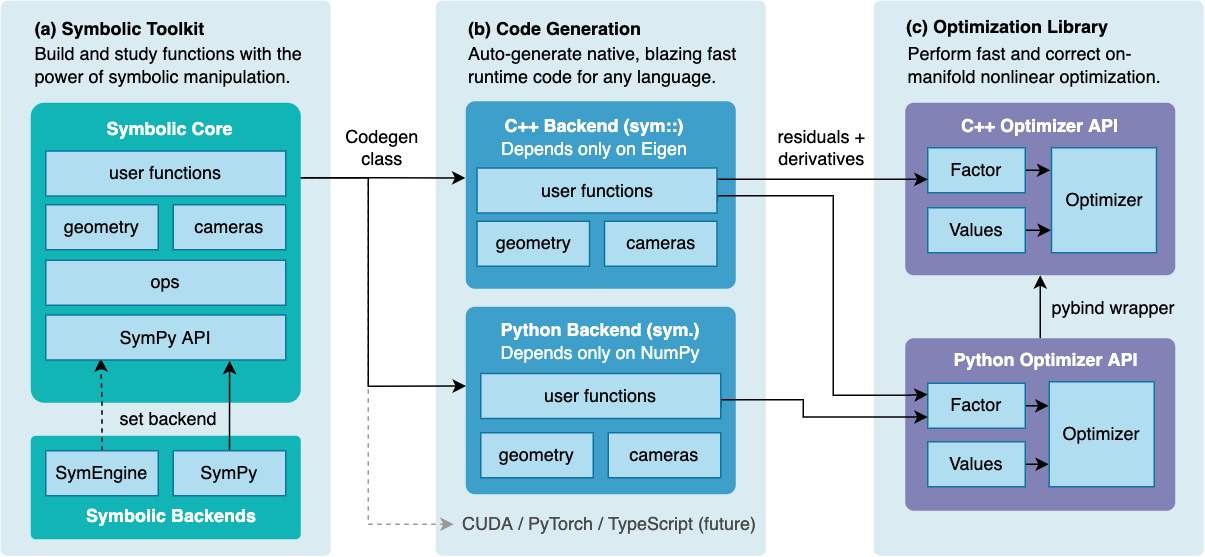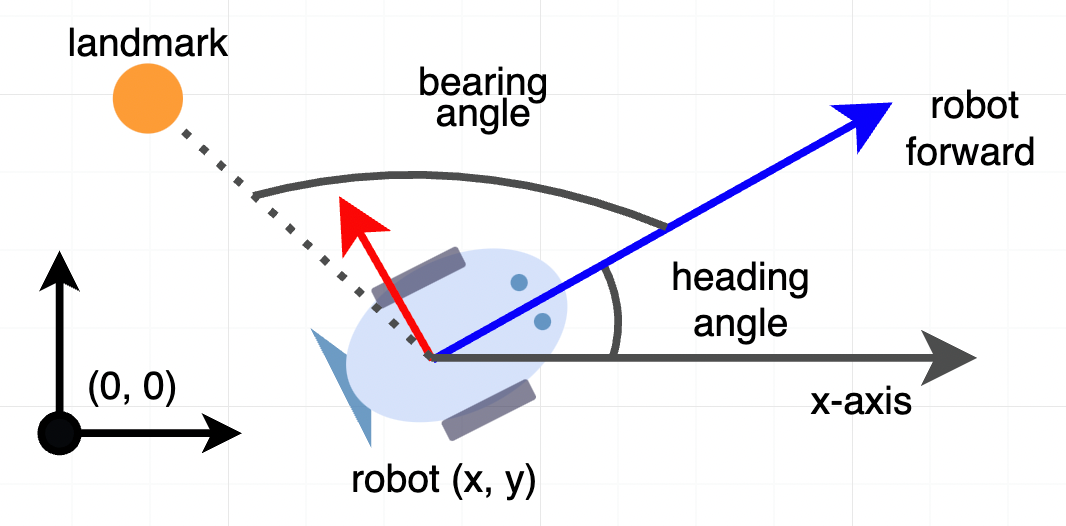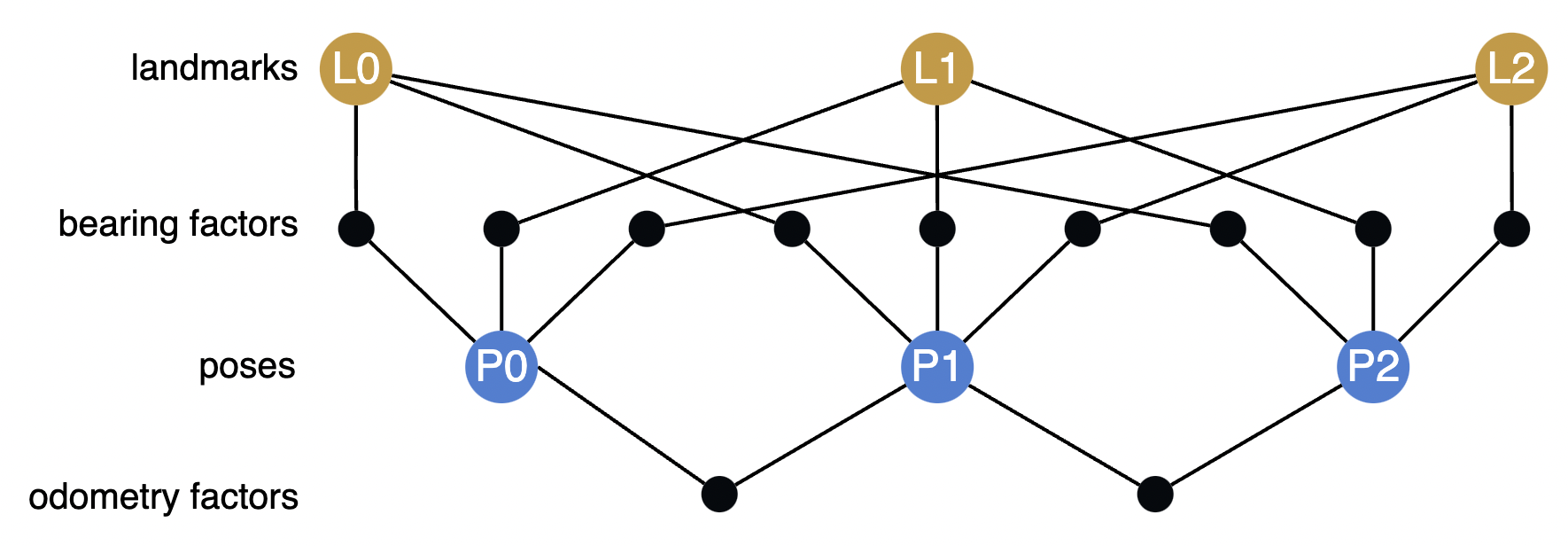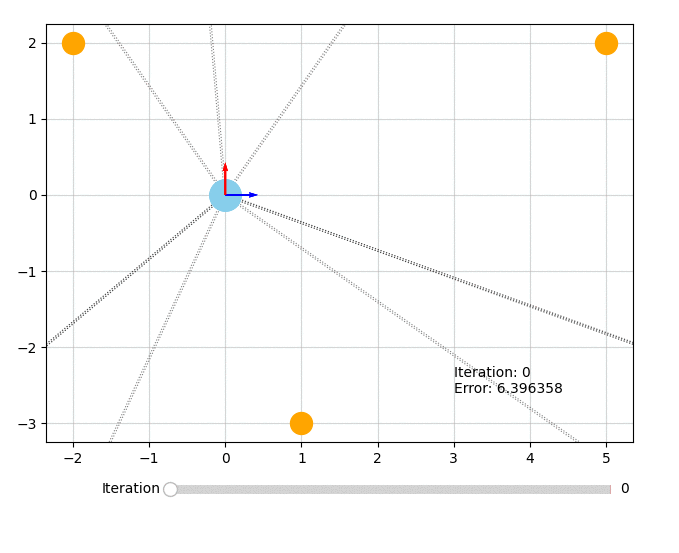
SymForce is a fast symbolic computation and code generation library for robotics applications like computer vision, state estimation, motion planning, and controls. It combines the development speed and flexibility of symbolic mathematics with the performance of autogenerated, highly optimized code in C++ or any target runtime language. SymForce contains three independently useful systems:
-
Symbolic Toolkit - builds on the SymPy API to provide rigorous geometric and camera types, lie group calculus, singularity handling, and tools to model complex problems
-
Code Generator - transforms symbolic expressions into blazing-fast, branchless code with clean APIs and minimal dependencies, with a template system to target any language
-
Optimization Library - a fast tangent-space optimization library based on factor graphs, with a highly optimized implementation for real-time robotics applications
SymForce automatically computes tangent space Jacobians, eliminating the need for any bug-prone handwritten derivatives. Generated functions can be directly used as factors in our nonlinear optimizer. This workflow enables faster runtime functions, faster development time, and fewer lines of handwritten code versus alternative methods.
SymForce is developed and maintained by Skydio. It is used in production to accelerate tasks like SLAM, bundle adjustment, calibration, and sparse nonlinear MPC for autonomous robots at scale.
- Symbolic implementations of geometry and camera types with Lie group operations
- Code generation of fast native runtime code from symbolic expressions, reducing duplication and minimizing bugs
- Novel tools to compute fast and correct tangent-space jacobians for any expression, avoiding all handwritten derivatives
- Strategies for flattening computation and leveraging sparsity that can yield 10x speedups over standard autodiff
- A fast tangent-space optimization library in C++ and Python based on factor graphs
- Rapid prototyping and analysis of complex problems with symbolic math, with a seamless workflow into production use
- Embedded-friendly C++ generation of templated Eigen code with zero dynamic memory allocation
- Highly performant, modular, tested, and extensible code
Thank you for helping us develop SymForce! We value the time you're taking to provide feedback during this private beta program. We expect some rough edges and slow, missing, or confusing aspects of the library. Please file issues on GitHub and we will work to address them.
Things to try:
- Review our tutorials and documentation
- Create symbolic expressions in a notebook
- Use the symbolic geometry and camera modules
- Compute tangent-space jacobians using
symforce/jacobian_helpers.py - Use the Python Factor and Optimizer to solve a problem
- Generate runtime C++ code with the Codegen class
- Use the generated C++ geometry module
- Use the C++ Factor and Optimizer to solve a problem
- Read and understand the SymForce codebase
SymForce requires Python 3.8 or later. We suggest using conda or virtualenv:
conda create --name symforce "python>=3.8"
conda activate symforce
Install packages:
# Linux
apt install doxygen libgmp-dev pandoc
# Mac
brew install doxygen gmp pandoc
# Conda
conda install -c conda-forge doxygen gmp pandoc
Install python requirements:
pip install -r requirements.txt
Install CMake if you don't already have a recent version:
pip install "cmake>=3.17"
Build SymForce (requires C++14 or later):
mkdir build
cd build
cmake ..
make -j 7
If you have build errors, try updating CMake.
Install built Python packages:
cd ..
pip install -e build/lcmtypes/python2.7
pip install -e gen/python
pip install -e .
Verify the installation in Python:
>>> from symforce import geo
>>> geo.Rot3()TODO: Create wheels for pip install symforce
Let's walk through a simple example of modeling and solving an optimization problem with SymForce. In this example a robot moves through a 2D plane and the goal is to estimate its pose at multiple time steps given noisy measurements.
The robot measures:
- the distance it traveled from an odometry sensor
- relative bearing angles to known landmarks in the scene
The robot's heading angle is defined counter-clockwise from the x-axis, and its relative bearing measurements are defined from the robot's forward direction:
Import the augmented SymPy API and geometry module:
from symforce import sympy as sm
from symforce import geoCreate a symbolic 2D pose and landmark location. Using symbolic variables lets us explore and build up the math in a pure form.
pose = geo.Pose2(
t=geo.V2.symbolic("t"),
R=geo.Rot2.symbolic("R")
)
landmark = geo.V2.symbolic("L")Let's transform the landmark into the local frame of the robot. We choose to represent poses as
world_T_body, meaning that to take a landmark in the world frame and get its position in the body
frame, we do:
landmark_body = pose.inverse() * landmarkYou can see that geo.Rot2 is represented internally by a complex number (𝑅𝑟𝑒, 𝑅𝑖𝑚) and we can study how it rotates the landmark 𝐿.
For exploration purposes, let's take the jacobian of the body-frame landmark with respect to the tangent space of the Pose2, parameterized as (𝑥, 𝑦, 𝜃):
landmark_body.jacobian(pose)Note that even though the orientation is stored as a complex number, the tangent space is a scalar angle and SymForce understands that.
Now compute the relative bearing angle:
sm.atan2(landmark_body[1], landmark_body[0])One important note is that atan2 is singular at (0, 0). In SymForce we handle this by placing a symbol ϵ (epsilon) that preserves the value of an expression in the limit of ϵ → 0, but allows evaluating at runtime with a very small nonzero value. Functions with singularities accept an epsilon argument:
geo.V3.symbolic("x").norm(epsilon=sm.epsilon)TODO: Link to a detailed epsilon tutorial once created.
We will model this problem as a factor graph and solve it with nonlinear least-squares.
The residual function comprises of two terms - one for the bearing measurements and one for the odometry measurements. Let's formalize the math we just defined for the bearing measurements into a symbolic residual function:
from symforce import typing as T
def bearing_residual(
pose: geo.Pose2, landmark: geo.V2, angle: T.Scalar, epsilon: T.Scalar
) -> geo.V1:
t_body = pose.inverse() * landmark
predicted_angle = sm.atan2(t_body[1], t_body[0], epsilon=epsilon)
return geo.V1(sm.wrap_angle(predicted_angle - angle))This function takes in a pose and landmark variable and returns the error between the predicted bearing angle and a measured value. Note that we call sm.wrap_angle on the angle difference to prevent wraparound effects.
The residual for distance traveled is even simpler:
def odometry_residual(
pose_a: geo.Pose2, pose_b: geo.Pose2, dist: T.Scalar, epsilon: T.Scalar
) -> geo.V1:
return geo.V1((pose_b.t - pose_a.t).norm(epsilon=epsilon) - dist)Now we can create Factor objects from the residual functions and a set of keys. The keys are named strings for the function arguments, which will be accessed by name from a Values class we later instantiate with numerical quantities.
from symforce.opt.factor import Factor
num_poses = 3
num_landmarks = 3
factors = []
# Bearing factors
for i in range(num_poses):
for j in range(num_landmarks):
factors.append(Factor(
residual=bearing_residual,
keys=[f"poses[{i}]", f"landmarks[{j}]", f"angles[{i}][{j}]", "epsilon"],
))
# Odometry factors
for i in range(num_poses - 1):
factors.append(Factor(
residual=odometry_residual,
keys=[f"poses[{i}]", f"poses[{i + 1}]", f"distances[{i}]", "epsilon"],
))Here is a visualization of the structure of this factor graph:
Our goal is to find poses of the robot that minimize the residual of this factor graph, assuming the
landmark positions in the world are known. We create an
Optimizer
with these factors and tell it to only optimize the pose keys (the rest are held constant):
from symforce.opt.optimizer import Optimizer
optimizer = Optimizer(
factors=factors,
optimized_keys=[f"poses[{i}]" for i in range(num_poses)],
# So that we save more information about each iteration, to visualize later:
debug_stats=True,
)Now we need to instantiate numerical Values for the problem, including an initial guess for our unknown poses (just set them to identity).
import numpy as np
from symforce.values import Values
initial_values = Values(
poses=[geo.Pose2.identity()] * num_poses,
landmarks=[geo.V2(-2, 2), geo.V2(1, -3), geo.V2(5, 2)],
distances=[1.7, 1.4],
angles=np.deg2rad([[145, 335, 55], [185, 310, 70], [215, 310, 70]]).tolist(),
epsilon=sm.default_epsilon,
)Now run the optimization! This returns an Optimizer.Result object that contains the optimized values, error statistics, and per-iteration debug stats (if enabled).
result = optimizer.optimize(initial_values)Let's visualize what the optimizer did. The orange circles represent the fixed landmarks, the blue circles represent the robot, and the dotted lines represent the bearing measurements.
from symforce.examples.robot_2d_triangulation.plotting import plot_solution
plot_solution(optimizer, result)All of the code for this example can also be found in symforce/examples/robot_2d_triangulation.
SymForce provides sym packages with runtime code for geometry and camera types that are generated from its symbolic geo and cam packages. As such, there are multiple versions of a class like Pose3 and it can be a common source of confusion.
The canonical symbolic class geo.Pose3 lives in the symforce package:
from symforce import geo
geo.Pose3.identity()The autogenerated Python runtime class sym.Pose3 lives in the sym package:
import sym
sym.Pose3.identity()The autogenerated C++ runtime class sym::Pose3 lives in the sym:: namespace:
sym::Pose3<double>::Identity()The matrix type for symbolic code is geo.Matrix, for generated Python is numpy.ndarray, and for C++ is Eigen::Matrix.
The symbolic classes can also handle numerical values, but will be dramatically slower than the generated classes. The symbolic classes must be used when defining functions for codegen and optimization. Generated functions always accept the runtime types.
The Codegen or Factor objects require symbolic types and functions to do math and generate code. However, once code is generated, numerical types should be used when invoking generated functions and in the initial values when calling the Optimizer.
As a convenience, the Python Optimizer class can accept symbolic types in its Values and convert to numerical types before invoking generated functions. This is done in the tutorial example for simplicity.
Let's look under the hood to understand how that optimization worked. For each factor, SymForce introspects the form of the symbolic function, passes through symbolic inputs to build an output expression, automatically computes tangent-space jacobians of those output expressions wrt the optimized variables, and generates fast runtime code for them.
The Codegen class is the central tool for generating runtime code from symbolic expressions. In this case, we pass it the bearing residual function and configure it to generate C++ code:
from symforce.codegen import Codegen, CppConfig
codegen = Codegen.function(bearing_residual, config=CppConfig())We can then create another Codegen object that computes a Gauss-Newton linearization from this Codegen object. It does this by introspecting and symbolically differentiating the given arguments:
codegen_linearization = codegen.with_linearization(
which_args=["pose"]
)Generate a C++ function that computes the linearization wrt the pose argument:
metadata = codegen_linearization.generate_function()
print(open(metadata["generated_files"][0]).read())This C++ code depends only on Eigen and computes the results in a single flat function that shares all common sub-expressions:
#pragma once
#include <Eigen/Dense>
#include <sym/pose2.h>
namespace sym {
/**
* Residual from a relative bearing mesurement of a 2D pose to a landmark.
* jacobian: (1x3) jacobian of res wrt arg pose (3)
* hessian: (3x3) Gauss-Newton hessian for arg pose (3)
* rhs: (3x1) Gauss-Newton rhs for arg pose (3)
*/
template <typename Scalar>
void BearingFactor(const sym::Pose2<Scalar>& pose, const Eigen::Matrix<Scalar, 2, 1>& landmark,
const Scalar angle, const Scalar epsilon,
Eigen::Matrix<Scalar, 1, 1>* const res = nullptr,
Eigen::Matrix<Scalar, 1, 3>* const jacobian = nullptr,
Eigen::Matrix<Scalar, 3, 3>* const hessian = nullptr,
Eigen::Matrix<Scalar, 3, 1>* const rhs = nullptr) {
// Total ops: 79
// Input arrays
const Eigen::Matrix<Scalar, 4, 1>& _pose = pose.Data();
// Intermediate terms (24)
const Scalar _tmp0 = _pose[1] * _pose[2];
const Scalar _tmp1 = _pose[0] * _pose[3];
const Scalar _tmp2 = _pose[0] * landmark(1, 0) - _pose[1] * landmark(0, 0);
const Scalar _tmp3 = _tmp0 - _tmp1 + _tmp2;
const Scalar _tmp4 = _pose[0] * _pose[2] + _pose[1] * _pose[3];
const Scalar _tmp5 = _pose[1] * landmark(1, 0);
const Scalar _tmp6 = _pose[0] * landmark(0, 0);
const Scalar _tmp7 = -_tmp4 + _tmp5 + _tmp6;
const Scalar _tmp8 = _tmp7 + epsilon * ((((_tmp7) > 0) - ((_tmp7) < 0)) + Scalar(0.5));
const Scalar _tmp9 = -angle + std::atan2(_tmp3, _tmp8);
const Scalar _tmp10 =
_tmp9 - 2 * Scalar(M_PI) *
std::floor((Scalar(1) / Scalar(2)) * (_tmp9 + Scalar(M_PI)) / Scalar(M_PI));
const Scalar _tmp11 = std::pow(_tmp8, Scalar(2));
const Scalar _tmp12 = _tmp3 / _tmp11;
const Scalar _tmp13 = Scalar(1.0) / (_tmp8);
const Scalar _tmp14 = _pose[0] * _tmp12 + _pose[1] * _tmp13;
const Scalar _tmp15 = _tmp11 + std::pow(_tmp3, Scalar(2));
const Scalar _tmp16 = _tmp11 / _tmp15;
const Scalar _tmp17 = _tmp14 * _tmp16;
const Scalar _tmp18 = -_pose[0] * _tmp13 + _pose[1] * _tmp12;
const Scalar _tmp19 = _tmp16 * _tmp18;
const Scalar _tmp20 = -_tmp12 * (_tmp0 - _tmp1 + _tmp2) + _tmp13 * (_tmp4 - _tmp5 - _tmp6);
const Scalar _tmp21 = _tmp16 * _tmp20;
const Scalar _tmp22 = std::pow(_tmp8, Scalar(4)) / std::pow(_tmp15, Scalar(2));
const Scalar _tmp23 = _tmp14 * _tmp22;
// Output terms (4)
if (res != nullptr) {
Eigen::Matrix<Scalar, 1, 1>& _res = (*res);
_res(0, 0) = _tmp10;
}
if (jacobian != nullptr) {
Eigen::Matrix<Scalar, 1, 3>& _jacobian = (*jacobian);
_jacobian(0, 0) = _tmp17;
_jacobian(0, 1) = _tmp19;
_jacobian(0, 2) = _tmp21;
}
if (hessian != nullptr) {
Eigen::Matrix<Scalar, 3, 3>& _hessian = (*hessian);
_hessian(0, 0) = std::pow(_tmp14, Scalar(2)) * _tmp22;
_hessian(0, 1) = 0;
_hessian(0, 2) = 0;
_hessian(1, 0) = _tmp18 * _tmp23;
_hessian(1, 1) = std::pow(_tmp18, Scalar(2)) * _tmp22;
_hessian(1, 2) = 0;
_hessian(2, 0) = _tmp20 * _tmp23;
_hessian(2, 1) = _tmp18 * _tmp20 * _tmp22;
_hessian(2, 2) = std::pow(_tmp20, Scalar(2)) * _tmp22;
}
if (rhs != nullptr) {
Eigen::Matrix<Scalar, 3, 1>& _rhs = (*rhs);
_rhs(0, 0) = _tmp10 * _tmp17;
_rhs(1, 0) = _tmp10 * _tmp19;
_rhs(2, 0) = _tmp10 * _tmp21;
}
}
} // namespace symSymForce can also generate runtime Python code that depends only on numpy.
The code generation system is written with pluggable jinja templates to minimize the work to add new backend languages. Some of our top candidates to add are TypeScript, CUDA, and PyTorch.
Now that we can generate C++ functions for each residual function, we can also run the optimization purely from C++ to get Python entirely out of the loop for production use.
const int num_poses = 3;
const int num_landmarks = 3;
std::vector<sym::Factor<double>> factors;
// Bearing factors
for (int i = 0; i < num_poses; ++i) {
for (int j = 0; j < num_landmarks; ++j) {
factors.push_back(sym::Factor<double>::Hessian(
&sym::BearingFactor,
{{'P', i}, {'L', j}, {'a', i, j}, {'e'}}, // keys
{{'P', i}} // keys to optimize
));
}
}
// Odometry factors
for (int i = 0; i < num_poses - 1; ++i) {
factors.push_back(sym::Factor<double>::Hessian(
&sym::OdometryFactor,
{{'P', i}, {'P', i + 1}, {'d', i}, {'e'}}, // keys
{{'P', i}, {'P', i + 1}} // keys to optimize
));
}
sym::Optimizer<double> optimizer(
params,
factors,
sym::kDefaultEpsilon<double>
);
sym::Values<double> values;
for (int i = 0; i < num_poses; ++i) {
values.Set({'P', i}, sym::Pose2::Identity());
}
// ... (initialize all keys)
// Optimize!
const auto stats = optimizer.Optimize(&values);
std::cout << "Optimized values:" << values << std::endl;This tutorial shows the central workflow in SymForce for creating symbolic expressions, generating code, and optimizing. This approach works well for a wide range of complex problems in robotics, computer vision, and applied science.
However, each piece may also be used independently. The optimization machinery can work with handwritten functions, and the symbolic math and code generation is useful outside of any optimization context.
You can find more SymForce tutorials here.
SymForce is released under the Apache 2.0 license.
See the LICENSE file for more information.
SymForce is developed and maintained by Skydio. It is released as a free and open-source library for the robotics community. Contributors to the project are welcome!

There are several features we'd like to add, or would be happy to see added by contributors from the community. Some of these are outlined in the current Issues, but some other major possible additions are:
- Easily swap in approximate or architecture-specific implementations of primitive functions, such as trig functions
- Add more backend languages, such as CUDA, GLSL/HLSL, and TypeScript
- More Lie group types, in particular Sim(3)







